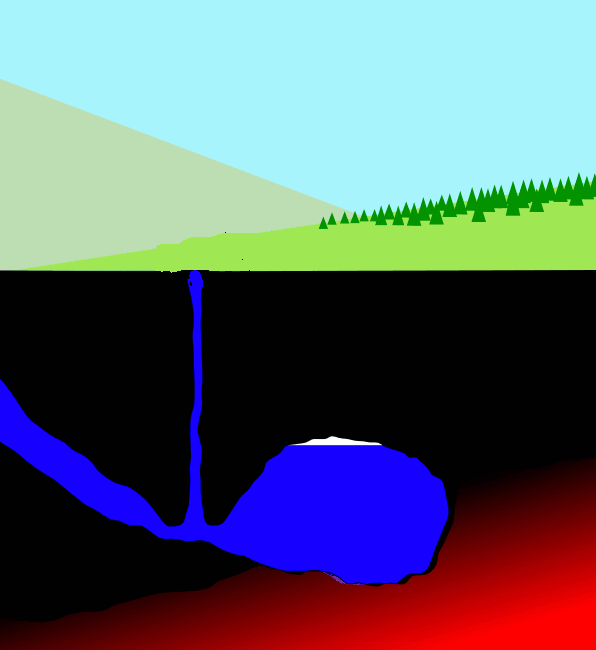I've been researching a land vehicle concept that takes advantage of a maneuver more commonly used in spacecraft propulsion-- the oberth maneuver.
A more complete discussion of the physics can be found here:
Land Based Oberth Manuever?
I hope it can be built one day because it uses only sustainable fuel- namely a combination of gravitational potential energy, solar, and geothermal.
It requires an underground tunnel, magnetic levitation, and a vacuum tunnel, like the hyperloop, but uses a different form of propulsion, and the tunnel has to be deep.
In essence it's a giant underground skateboard ramp, with an electric motor that pushes off a moving water tank instead of the ground to go faster than an airplane.
I’ve done some back of the napkin calculations to compare a Tesla Model S vs a wormhole vehicle of the same mass & available energy. These are rough numbers just to give an ideal of the potential performance and compare with an automobile.
Long story short with it’s lithium battery pack partially charged up with 45kWh of energy, at roughly 70mph the 2250kg Tesla can do 135 miles in about 115.2 minutes (3mi/kWh). At 13.3 cents per kWh, it costs $5.98 for the energy. The ratio of kinetic energy to total kWH consumed with the Tesla on this trip is about 6.78%.
The land based oberth maneuver vehicle also weighs 2250kg and has 45kWh energy and follows a ramp (maglev in vacuum) which is 4.4km deep. It consists of a 1350kg passenger section (16.22kWh gravitational potential energy), 750kg water (9.01kWh gravitational potential energy), and a 150kg tank (1.8kWh gravitational potential energy) and 18.03kWh of electromechanical potential stored in capacitors in the track. The vehicle coasts down the ramp reaching about 294m/s at the bottom (657mph). The water tank is ahead of the passenger section on a long tether. On the flat section at the bottom of the ramp, the passenger section "reels in" then releasesthe tank with the 18.03kWh electromechanical potential, bringing the tank to a halt on the tracks, transferring all its kinetic energy plus the mechanical impulse to the passenger section. After the mechanical impulse at the bottom of the ramp between the tank and passenger section, the 1350kg passenger section is traveling 1096mph, can go 135 miles in 7.38 minutes (about 15.6x faster). At $0.004/gallon the water costed $0.79 (less than 1/7th the energy cost). The ratio of kinetic energy to total kWH consumed with the wormhole is about 100% (~93.2% more battery energy was converted to kinetic energy).
After traveling up a second ramp back to the surface, the passenger section still has 28.8kWh of kinetic energy. The water is emptied from the tank at the bottom of the ramp and only the empty tank is lifted (the water is left to evaporate). Factoring regen braking with 70% kinetic-to-kinetic efficiency at the destination, and using some of the recovered energy to recharge the capacitors, and some of the energy lift the empty tank, there is still a 0.36kWh excess of recovered from the regen above and beyond the energy used to push the vehicle at the ramp bottom. The excess energy comes from the lowered gravitational potential energy of the water left to evaporate at the bottom of the tunnel. It isn't perpetual motion because the vehicle requires gravitational potential energy to move itself forward, and geothermal and solar energy to lift the water out of the tunnel.
In summary the hypothetical land based oberth maneuver vehicle can theoretically go 15.6x faster, for less than 1/7th the energy cost, with the same amount of energy and mass as a Tesla Model S.


A more complete discussion of the physics can be found here:
Land Based Oberth Manuever?
I hope it can be built one day because it uses only sustainable fuel- namely a combination of gravitational potential energy, solar, and geothermal.
It requires an underground tunnel, magnetic levitation, and a vacuum tunnel, like the hyperloop, but uses a different form of propulsion, and the tunnel has to be deep.
In essence it's a giant underground skateboard ramp, with an electric motor that pushes off a moving water tank instead of the ground to go faster than an airplane.
I’ve done some back of the napkin calculations to compare a Tesla Model S vs a wormhole vehicle of the same mass & available energy. These are rough numbers just to give an ideal of the potential performance and compare with an automobile.
Long story short with it’s lithium battery pack partially charged up with 45kWh of energy, at roughly 70mph the 2250kg Tesla can do 135 miles in about 115.2 minutes (3mi/kWh). At 13.3 cents per kWh, it costs $5.98 for the energy. The ratio of kinetic energy to total kWH consumed with the Tesla on this trip is about 6.78%.
The land based oberth maneuver vehicle also weighs 2250kg and has 45kWh energy and follows a ramp (maglev in vacuum) which is 4.4km deep. It consists of a 1350kg passenger section (16.22kWh gravitational potential energy), 750kg water (9.01kWh gravitational potential energy), and a 150kg tank (1.8kWh gravitational potential energy) and 18.03kWh of electromechanical potential stored in capacitors in the track. The vehicle coasts down the ramp reaching about 294m/s at the bottom (657mph). The water tank is ahead of the passenger section on a long tether. On the flat section at the bottom of the ramp, the passenger section "reels in" then releasesthe tank with the 18.03kWh electromechanical potential, bringing the tank to a halt on the tracks, transferring all its kinetic energy plus the mechanical impulse to the passenger section. After the mechanical impulse at the bottom of the ramp between the tank and passenger section, the 1350kg passenger section is traveling 1096mph, can go 135 miles in 7.38 minutes (about 15.6x faster). At $0.004/gallon the water costed $0.79 (less than 1/7th the energy cost). The ratio of kinetic energy to total kWH consumed with the wormhole is about 100% (~93.2% more battery energy was converted to kinetic energy).
After traveling up a second ramp back to the surface, the passenger section still has 28.8kWh of kinetic energy. The water is emptied from the tank at the bottom of the ramp and only the empty tank is lifted (the water is left to evaporate). Factoring regen braking with 70% kinetic-to-kinetic efficiency at the destination, and using some of the recovered energy to recharge the capacitors, and some of the energy lift the empty tank, there is still a 0.36kWh excess of recovered from the regen above and beyond the energy used to push the vehicle at the ramp bottom. The excess energy comes from the lowered gravitational potential energy of the water left to evaporate at the bottom of the tunnel. It isn't perpetual motion because the vehicle requires gravitational potential energy to move itself forward, and geothermal and solar energy to lift the water out of the tunnel.
In summary the hypothetical land based oberth maneuver vehicle can theoretically go 15.6x faster, for less than 1/7th the energy cost, with the same amount of energy and mass as a Tesla Model S.








